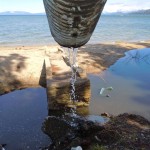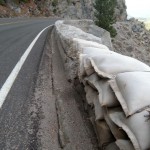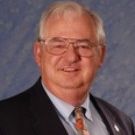By Kathryn Reed
Even though Caltrans will break ground today on a $40 million project to improve water quality, the pipes that carry runoff into Lake Tahoe will continue to muck up the scenic corridor to keep it looking more like a Third World beach community than a world-class destination.
Billions of dollars have been spent and are slated to be spent on lake clarity. But that measurement has everything to do with what a dinner plate of sorts looks like and nothing to do with the near shore, which is where people swim and what they look at from a pier.

Untreated water flows directly into Lake Tahoe. All photos are from April 17, 2011, in South Tahoe. Photos/Kathryn Reed
About a half dozen pipes from El Dorado Beach to Ski Run Marina bring untreated water into Lake Tahoe. All carry the oils and gunk from Highway 50, along with sediment from the mountain side of the road that runs through South Lake Tahoe. Some of that water carries fertilizer from Bijou Golf Course to the lake.
This is always the best time of year to see what flows into Tahoe because of the snowmelt. The high-mark for runoff is not likely to be reached until late May or early June, so the flow of water will continue at a good clip for at least another month.
Garbage is strewn about at some of these outflows. The outflow near Lakeshore Lodge and Spa is clogged because it is a grate. The water is a rusty orange-brown color. It flows east, discoloring the water all the way to Ski Run Marina. It goes out into the lake well past the end point of the pier at Lakeland Village.
Although the much-heralded Trout Creek to Ski Run Boulevard highway improvement project will help prevent some of the less desirable nutrients from reaching the lake, it won’t solve the entire problem.
Part of the issue is Caltrans does not own the pipes so the state agency is not replacing them. So, even if cleaner water flows from some of them, those unsightly discharge pipes will remain.
No official could tell Lake Tahoe News who owns all of the pipes, but the city of South Lake Tahoe is responsible for most.
Another issue is not all of the pipes carrying untreated water are part of the Highway 50 project.
“The outfall at Lakeview Commons is not getting any treatment at lake level. That is in the second phase of the project, of which there is no funding for,” said Jim Marino, capital improvement project manager for South Lake Tahoe. “Caltrans is providing all the pre-treatment facilities on the highway to clean up the water.”
(The contractor started mobilizing at Lakeview Commons near El Dorado Beach last week and expects to start work May 2 on phase one.)
“The Alta Mira (outflow) is a little unclear. There is some talk by the California Tahoe Conservancy to purchase those properties to expand Lakeview Commons and in that case that outfall,” Marino explained. “But right now it’s only getting pre-treatment on the highway so it should be cleaner, but the ugly look will probably stay.”
This area is at the east end of the pedestrian area where from the highway the lake is no longer visible.
Bijou project
There isn’t anything Lakeshore Lodge or Lakeland Village can do about the nasty water coming out of the pipe by the Bijou Center. General managers of both properties told Lake Tahoe News the Bijou erosion control project can’t start soon enough.
They will have to wait until 2013 – or later.
“That is a landmark project the city is undertaking. That will be a pump and treatment system,” Marino explained. “It will take the mucky stormwater out of the Bijou neighborhood and pump it back into the meadow and allow the meadow to discharge and cleanse it out. It’s a complex project.”
With 95 percent of the funding in place, the city hopes to start on it in two years.
Pat Ronan, who runs Lakeshore Lodge and Spa, said his guests will comment on the unsightly pipe, but his employees explain what it is and that it’s runoff starting at Heavenly Mountain Resort that winds up on the edge of his beach.
Although Jerry Bindel at Lakeland Village collects, treats and monitors the runoff from his property’s parking lots, he can’t stop the trail of orange water from flowing in front of his complex this time of year from the Bijou pipe.
Two pipes from his property carry water to the lake, though they are buried under the sand. Both are visible from the shore.
“The ones coming from our beach don’t (bother guests). We have some pretty strict guidelines on property to make sure nothing gets into the lake from our property,” Bindel said.
Permitting agencies
Lahontan Regional Water Quality Control Board and Tahoe Regional Planning Agency issued permits for the multi-year highway project that will bring improvements to both sides of Highway 50.
“The water, hopefully, coming out of them will be a lot cleaner, but it will still be an eyesore. I understand they look ugly,” Bud Amorfini, engineering geologist with Lahontan, said of the culverts.
Although detention basins are the optimal choice for treating stormwater runoff, that is not possible with the highway so close to the lake. That is why sand vaults and Delaware sand filters will be used.
But the goal, Amorfini said, is all the water in that section of the highway will be treated in some manner before it reaches Lake Tahoe. That will be a marked difference from what goes on today and has been allowed to happen for years.
With the Total Maximum Daily Load requirements passed last week by the state water board – which the Environmental Protection Agency must still sign-off on – this highway project will allow Caltrans to receive credit for reducing the amount of sediment reaching the lake.
This road project also qualifies as an Environmental Improvement Project under the oversight of TRPA.
“Highway 50 Trout Creek to Ski Run is an example of an area that needed full treatment, but which also needed roadwork, landscaping, pedestrian and bicycle improvements, so it naturally took a long time to plan and fund,” Jeff Cowen, TRPA spokesman, said. “The NEAT (Natural Environment As Treatment) plan lays out Caltrans projects to infiltrate all stormwater from its roads in the basin. They are accountable to that plan.”
Caltrans spokeswoman Deanna Shoopman said crews are bringing in equipment, putting up fencing and doing other staging work this week. Work that would interfere with traffic will not begin until after May 15 – when the first stage of the Amgen Tour de California bike race on the South Shore is over.
Improvements coming
The project begins on the west side of the city near the Trout Creek bridge by Meeks Lumber and goes to Ski Run Boulevard.
With it being a water quality project, much of the work is happening under the road surface where the drainage – and treatment – of runoff will occur.
Sidewalks, 6-foot shoulders (aka bike lanes), and new signals are part of the plans. Lighting will occur on the mountain (south) side of the highway. Landscaping on both sides will be provided. Walkways will adhere to American with Disabilities Act regulations.
This project has been in the works for more than a decade.
The plan is to time as much of the Lakeview Commons work into Caltrans’ schedule so the same areas of town are not torn up more than once.
Although the end product will be visually and environmentally better, it won’t be without inconveniences.
This is the preliminary schedule, though Caltrans may change things or have updates at today’s 1pm groundbreaking ceremony at Campground by the Lake:
• April 25: Contractor began mobilization.
• April 25 to May 13: Contractor will set up BMPs for TRPA permit and pre-grade inspection.
• May 1 to Oct. 15: Utilities will relocate infrastructure.
• May 17: Contractor begins phase 1.
• Phase 1: 2011 construction season — Trout Creek to Ski Run westbound (lake side) curb, gutter, and streetscape.
• Phase 2: 2012 construction season — Ski Run to Trout Creek eastbound (mountain side) curb, gutter, and streetscape.
• Phase 3 – 2013 construction season — full limits both directions – grind, pave and stripe.
Expect lane closures for the three years of work. The contractor will be working day and night until July 1. From July 1 to Labor Day, contractor will work nights, with limited daytime work.
ngg_shortcode_1_placeholder (Click on photos to enlarge.)
 State Sen. Ted Gaines, R-Roseville, has stepped into the fray – again. He has arranged for a conference call for Monday with local officials and Caltrans District 3 Director Jody Jones.
State Sen. Ted Gaines, R-Roseville, has stepped into the fray – again. He has arranged for a conference call for Monday with local officials and Caltrans District 3 Director Jody Jones.









